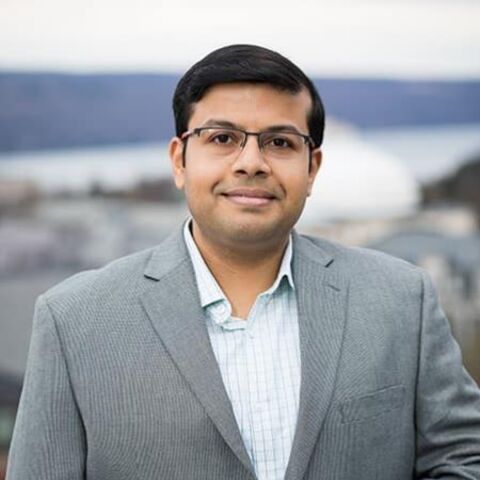News and Events
Full listing
March 17, 2023
As a freshman, Dan Ralph was inspired by an engaging physics teacher who Ralph considered a Yoda-like character who was very good at posing problems that helped them understand what they were learning.
Dan Ralph as co-director of Kavli Institute at Cornell (KIC) states "We're constantly looking for new puzzles, new problems, and new areas of research that people haven't considered before. Some involve fundamental science questions while others are more about engineering, but they are all areas where research can make a difference."
February 23, 2023
Researchers studying statistics applications in systems biology and next-generation wireless technology are among the nine Cornell faculty members, including Debanjan Chowdhury, who’ve received National Science Foundation Faculty Early Career Development Awards.
February 15, 2023
Assistant professors Eshan Chattopadhyay, Debanjan Chowdhury, Andrew Musser, Angeline Pendergrass and Andrej Singer have won 2023 Sloan Research Fellowships from the Alfred P. Sloan Foundation.
November 12, 2022
Huang says that from an early age she was concerned with climate change and spent a lot of time thinking about how to tackle pollution. She studied chemistry at Uppsala University before attaining her PhD in chemistry at Cornell in 2012, before going on to found Lionano, a company focused on improving the components within lithium-ion batteries.
“I realized batteries were going to be a big thing because they were the technology that could change transportation and the clean-tech landscape in the near term,” Huang says.
She unveiled Factorial last year alongside co-founders Alex Yu, the company’s president, and Héctor D. Abruña, Emile M. Chamot Professor in the Department of Chemistry and Chemical Biology in Cornell University’s College of Arts and Sciences.
October 18, 2022
On Oct. 17, Cornell Engineering held its inaugural EPICC Awards ceremony, celebrating both staff and faculty whose work exemplifies the college’s core values: excellence, purpose, innovation, community, and collaboration.
Collaboration
Claudia Fischbach-Teschl, the Stanley Bryer 1946 Professor of Biomedical Engineering, was honored for her numerous exceptional and sustained contributions to enhance collaborations not only within Cornell Engineering, but also across various colleges at Cornell, both in Ithaca and New York City.
October 17, 2022
For decades, scientists have been studying electrons by looking at common materials like silicon and observing one electron at a time. But lately, scientists have been excited by so-called quantum materials, in which trillions of electrons interact and influence each other—behavior that is evident in high-temperature superconductors.
“These new materials exhibit counterintuitive properties that can’t be described by treating these electrons one at a time,” says Debanjan Chowdhury, assistant professor of physics, in a Cornell Research profile. “Instead, we have to treat the electrons in these materials as one collective fluid in which electrons are strongly entangled with one another. We don’t even have the right kinds of technical tools and mathematical machinery to describe their properties reliably yet.”
October 10, 2022
J.C. Séamus Davis has been awarded the 2023 Oliver E. Buckley Prize from the American Physical Society. The award, which includes a prize of $20,000, recognizes outstanding theoretical or experimental contributions to condensed matter physics.
In a statement, the award committee said that Davis received the prize for his “innovative applications of scanning tunneling microscopy and spectroscopy to complex quantum states of matter.” The award is shared with Prof. Ali Yazdani of Princeton University.
October 5, 2022
A group of researchers led by Cornell is unlocking the full potential of aluminum nitride – an important material for the advancement of electronics and photonics – thanks to the development of a surface cleaning technique that enables high-quality production.
The research was published Sept. 9 in the journal Science Advances. Graduate student Zexuan Zhang and research associate Yongjin Cho are the lead authors. The senior authors are Debdeep Jena and Huili Grace Xing, both professors of materials science and engineering and of electrical and computer engineering.
September 23, 2022
Our guts, and all our organs, are arranged in left-right asymmetric patterns inside our bodies, so that everything may fit.
At the same time, development of organs such as the intestine is anything but haphazard. In healthy embryos, rotation of the gut during development always occurs in a counterclockwise direction and is perfectly timed. It’s a complicated process that scientists have long worked to understand.
, Click to open gallery view
Credit:Kurpios Lab/Provided
Chicken embryo intestinal tube where mechanical cues drive gene expression and gut patterning to prevent fatal obstructions.
Now, a study published Sept. 23 in the journal Science finds that gut rotation during development is orchestrated by two waves of expression of a transcription factor called Pitx2. The second wave, it turns out, is triggered by mechanical cues within an elastic tissue that anchors the gut tube, and later becomes a conduit for blood and lymphatic vessels that supply the gut tube.
September 21, 2022
A collaborative effort has installed electronic “brains” on solar-powered robots that are 100 to 250 micrometers in size – smaller than an ant’s head – so that they can walk autonomously without being externally controlled.
While Cornell researchers and others have previously developed microscopic machines that can crawl, swim, walk and fold themselves up, there were always “strings” attached; to generate motion, wires were used to provide electrical current or laser beams had to be focused directly onto specific locations on the robots.
“Before, we literally had to manipulate these ‘strings’ in order to get any kind of response from the robot,” said Itai Cohen, professor of physics in the College of Arts and Sciences. “But now that we have these brains on board, it’s like taking the strings off the marionette. It’s like when Pinocchio gains consciousness.”









